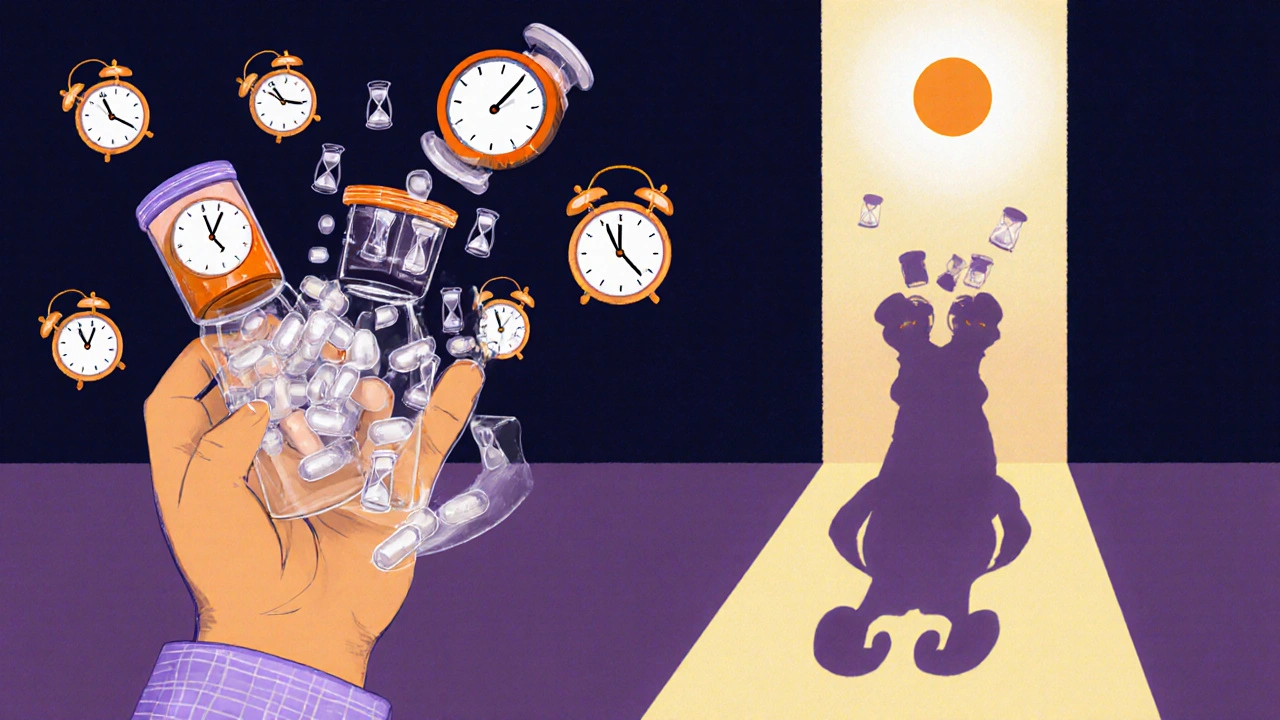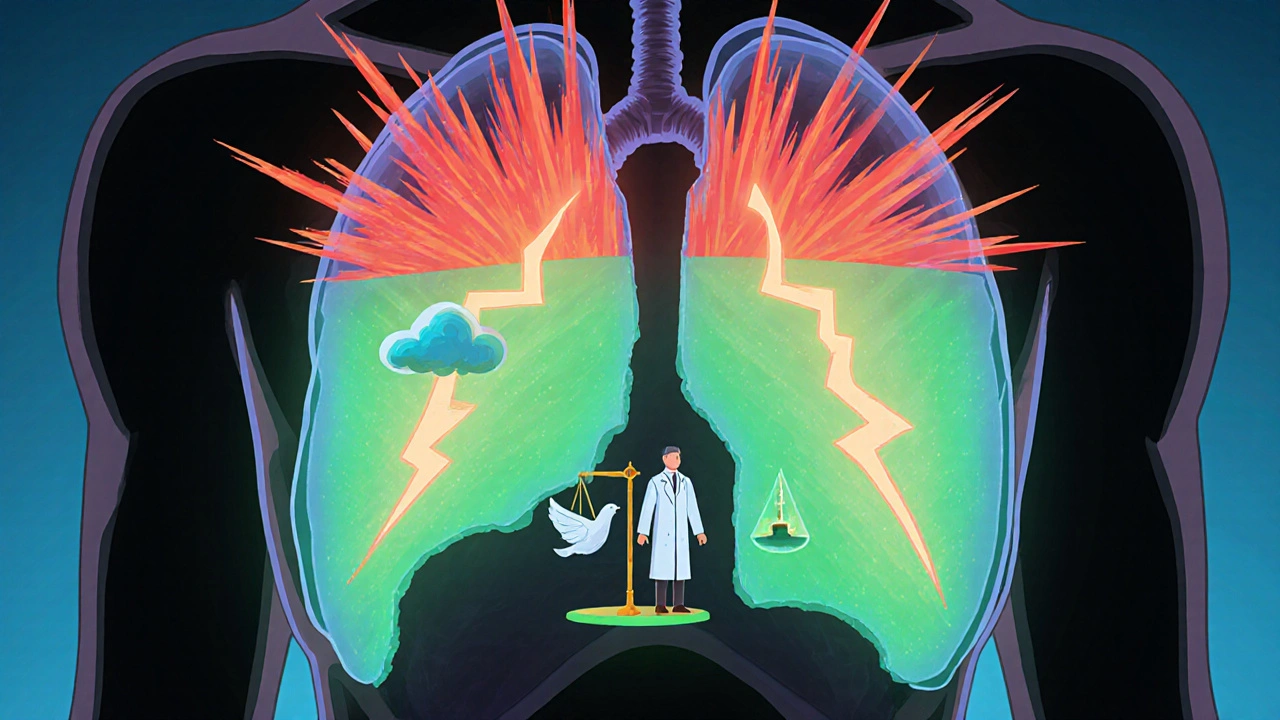Both isosorbide dinitrate and isosorbide mononitrate are used to treat angina - that tight, squeezing pain in your chest when your heart doesn’t get enough oxygen. They’re both nitrates, both help relax blood vessels, and both are taken daily by people with heart conditions. But they’re not the same. If you’ve been prescribed one and are wondering why not the other, or if you’re switching between them, understanding the real differences matters - not just for your heart, but for your daily routine too.
How They Work: Same Goal, Different Timing
Both drugs release nitric oxide in your body, which tells your blood vessels to widen. That lowers blood pressure and reduces the workload on your heart. But how quickly they work and how long they last? That’s where they split.
Isosorbide dinitrate hits fast. You’ll feel its effects within 15 to 30 minutes after taking it. That’s why it’s often used for sudden angina attacks - especially if you know you’re about to do something that triggers chest pain, like climbing stairs or shoveling snow. It’s also taken two to three times a day because its effects wear off faster.
Isosorbide mononitrate, on the other hand, is slower to start but lasts longer. It can take up to an hour to kick in, so it’s not ideal for stopping an attack that’s already happening. But once it does, it sticks around for 6 to 12 hours. That’s why it’s usually taken just once or twice a day. Many people prefer it because it fits better into a morning routine - no need to remember a midday dose.
Dosing: Simplicity vs Flexibility
Isosorbide dinitrate comes in 5 mg, 10 mg, and 20 mg tablets. A typical starting dose is 5 mg to 20 mg, taken two or three times daily. That means three alarms on your phone, three times a day. Miss one, and your protection drops. If you’re someone who forgets pills, this can be a problem.
Isosorbide mononitrate is available in 20 mg, 30 mg, and 60 mg extended-release tablets. The most common dose is 30 mg or 60 mg once daily. Some versions are taken twice a day, but even then, it’s usually morning and afternoon - fewer disruptions. The extended-release version releases the drug slowly, so levels stay steady. That’s why doctors often choose it for long-term prevention.
Here’s the catch: you can’t swap them 1:1. Taking 20 mg of isosorbide dinitrate doesn’t equal 20 mg of isosorbide mononitrate. The body processes them differently. Switching without medical guidance can lead to underdosing - meaning more chest pain - or overdosing - causing dangerous drops in blood pressure.
Side Effects: Similar, But Not Identical
Both drugs cause headaches, dizziness, and low blood pressure. That’s normal. But the intensity and timing vary.
With isosorbide dinitrate, headaches often come on strong within the first hour and can be severe enough to make people stop taking it. That’s why some doctors start with a low dose and build up slowly.
Isosorbide mononitrate tends to cause milder headaches because the drug enters your system more gradually. People who couldn’t tolerate dinitrate due to headaches often do better on mononitrate. But it’s not guaranteed - some still get them.
Both can cause flushing, nausea, or lightheadedness, especially when standing up fast. That’s why you’re told to rise slowly. Neither should be mixed with erectile dysfunction drugs like Viagra or Cialis - the combo can crash your blood pressure to dangerous levels.

When Doctors Choose One Over the Other
Let’s say you’re 68, live alone, and have stable angina. You take a few other pills already. Your doctor is more likely to pick isosorbide mononitrate. Why? Simpler routine. Less chance you’ll forget. Less risk of side effects piling up.
Now imagine you’re 52, active, and your chest pain happens during exercise. You know your triggers. Your doctor might start you on isosorbide dinitrate - you take it 20 minutes before your morning walk. It gives you control. You can time it.
There’s also cost. In the UK, generic isosorbide mononitrate is often cheaper than dinitrate, especially the extended-release versions. If you’re paying out of pocket or your prescription co-pay is high, that matters.
And if you’ve been on dinitrate for years and it’s working? Don’t switch unless there’s a reason. Stability matters in heart care.
What Happens If You Mix Them Up?
People sometimes confuse the names. “Dinitrate” sounds like “mononitrate” - especially when you’re tired or stressed. But mixing them up can be risky.
Taking dinitrate when you meant to take mononitrate might cause your blood pressure to drop too fast - especially if you’re already on other blood pressure meds. You could feel faint, dizzy, or even pass out.
Going the other way - taking mononitrate when you need quick relief - won’t stop an angina attack. You’ll be stuck waiting 45 minutes while your chest tightens. That’s dangerous.
Always double-check the label. Look at the dose. Look at the name. If you’re unsure, call your pharmacist. They’ve seen this mix-up before.

Storage and Practical Tips
Both drugs are sensitive to heat and moisture. Keep them in their original bottles, away from the bathroom. Don’t transfer them to pill organizers unless you’re sure they’re stable - some extended-release forms break down if exposed to air too long.
Always carry a nitrate with you if you have a history of sudden angina. Keep it in your coat pocket, not your bag. Cold weather can slow absorption. Don’t store it in the car.
Don’t drink alcohol while taking either. It boosts the blood pressure-lowering effect and increases dizziness.
And if you feel your chest pain is getting worse, or you’re needing more doses than usual - that’s a red flag. Call your doctor. This isn’t normal.
Bottom Line: Pick Based on Your Life, Not Just the Prescription
Isosorbide dinitrate is for when you need fast, short-term relief. It’s flexible, but it demands more from you - more doses, more timing, more attention.
Isosorbide mononitrate is for steady, long-term protection. It’s simpler, quieter, and often easier to stick with.
Neither is better. One is just better for you. If your current medication works and you’re not having side effects, stick with it. If you’re struggling with dosing or headaches, talk to your doctor. There’s a good chance switching could make your life easier - without sacrificing your heart’s safety.
Can I take isosorbide dinitrate and isosorbide mononitrate together?
No, you should not take both at the same time unless specifically directed by your doctor. They work the same way and combining them increases the risk of dangerously low blood pressure, severe headaches, and dizziness. Doctors rarely prescribe both - if you need both types of action, they’ll adjust the dose or switch you to one that fits your needs better.
Which one is better for preventing angina at night?
Isosorbide mononitrate is preferred for nighttime angina prevention because of its long-lasting effect. Extended-release versions are designed to maintain steady drug levels through the night. Isosorbide dinitrate wears off too quickly to be effective overnight. If you wake up with chest pain, your doctor may switch you to mononitrate or adjust your timing - like taking your dose right before bed.
How long does it take for isosorbide mononitrate to start working?
Isosorbide mononitrate begins working within 30 to 60 minutes after you take it. But because it’s often formulated as an extended-release tablet, it doesn’t give you a sudden spike - it builds up slowly and lasts for up to 12 hours. That’s why it’s not used for sudden chest pain - it’s meant to prevent it.
Can I stop taking these medications if I feel better?
No. These drugs don’t cure angina - they manage it. Stopping suddenly can cause rebound angina, where your chest pain returns worse than before. Always talk to your doctor before making any changes. If your symptoms improve, it’s because the medication is working. Your doctor may adjust your dose, but never stop without guidance.
Are there natural alternatives to these drugs?
There are no proven natural alternatives that work like isosorbide dinitrate or mononitrate. Some supplements like L-arginine or beetroot juice may slightly improve blood flow, but they don’t replace nitrates for treating angina. Relying on them instead of prescribed medication can be life-threatening. Always discuss any supplements with your doctor - they can interact with your current meds.





Edward Weaver
November 6, 2025 AT 17:51Look, if you’re on this stuff and still getting chest pain, you’re probably doing it wrong. Dinitrate’s for emergencies, mononitrate’s for lazy people who don’t want to remember meds. I’ve been on both - dinitrate made me feel like a zombie with a headache for 3 hours. Mononitrate? Just chill. No drama. Stop overcomplicating it.
Lexi Brinkley
November 8, 2025 AT 11:05OMG YES 🙌 I switched to mononitrate last year and my headaches? GONE. 🥳 I used to need ibuprofen just to get out of bed after dinitrate. Now I take one pill in the AM and forget about it until bedtime. My pharmacist even gave me a sticker that says ‘Mononitrate Queen’ 😎
Kelsey Veg
November 9, 2025 AT 08:56soo like… dinitrate = fast but u gotta remember 3x a day? mononitrate = slow but u can sleep through it? i think i mixed them up last week and felt like i was gonna pass out lol. my doc was like ‘u idiot’ and switched me. now i just take it with my coffee. life changed. also, why do people keep saying ‘extended release’ like its magic? its just a fancy pill.
Alex Harrison
November 10, 2025 AT 17:24Just wanted to add that if you’re on blood pressure meds already, combining these with anything else can be risky. I had a friend who took dinitrate with his lisinopril and ended up in the ER because his BP dropped to 70 over 40. Don’t be that guy. Read the label. Even if you think you know what you’re doing. I typo’d ‘mononitrate’ as ‘mononitrate’ once and almost took the wrong one. Scary stuff.
Jay Wallace
November 10, 2025 AT 19:43Let’s be clear: the FDA doesn’t approve these drugs for ‘convenience.’ They’re pharmacologically distinct entities with differing pharmacokinetic profiles. Dinitrate’s bioavailability is 25% due to first-pass metabolism, whereas mononitrate’s is nearly 100%. The extended-release formulation of mononitrate utilizes a hydroxypropyl methylcellulose matrix - a proprietary delivery system that maintains plasma concentrations for 12+ hours. You’re not ‘just taking a pill.’ You’re participating in a precision cardiovascular intervention. And if you’re mixing them up? That’s not negligence - that’s medical malpractice waiting to happen.
Alyssa Fisher
November 11, 2025 AT 18:44It’s interesting how we reduce complex medical regimens to ‘easy’ or ‘hard’ based on how they fit into our routines. But the real question isn’t which pill is simpler - it’s which one lets you live the life you want. If you’re a runner who needs to climb hills without fear, dinitrate gives you agency. If you’re an older person managing 10 other meds, mononitrate gives you peace. Neither is ‘better.’ They’re just different tools for different stories. And maybe that’s the point - medicine isn’t about one-size-fits-all. It’s about fitting the medicine to the person.
Ankit Yadav
November 13, 2025 AT 07:03My uncle in Delhi was on dinitrate for years. He forgot doses, got dizzy, fell once. Switched to mononitrate - now he walks 5 km every morning. No more panic. Just calm. If your doctor doesn’t ask about your daily life, find a new one. Medicine should fit your rhythm, not break it.
Meghan Rose
November 14, 2025 AT 12:49Wait… so if I take mononitrate at night, will it stop my nighttime chest pain? I wake up gasping sometimes. Should I try it? I’m scared to ask my doctor. What if they think I’m being dramatic? I just want to sleep without my chest feeling like a vise. I’ve been too ashamed to say anything. Is this normal? Am I overreacting?